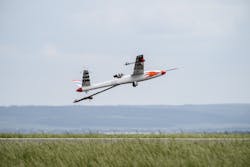Scientists tame dreaded aviation phenomenon
COCHSTEDT, Germany - A team of researchers in Europe has succeeded in overcoming an important challenge in aeroelasticity – the suppression of the phenomenon of flutter in an aircraft structure by means of an active control system. This feat was demonstrated in a flight campaign using a specially constructed Unmanned Aerial Vehicle (UAV), the German Aerospace Center (DLR) reports. Continue reading original article.
The Military & Aerospace Electronics take:
21 August 2023 - A team consisting of the German Aerospace Center (Deutsches Zentrum für Luft- und Raumfahrt; DLR), the Institute for Computer Science and Control (SZTAKI) from Hungary, the French Aerospace Lab (ONERA) and the Technical University of Munich (TUM) from Germany was funded under the EU Horizon 2020 framework. The successful flight tests took place at the National Experimental Test Center for Unmanned Aircraft Systems, which is operated by DLR and located in Cochstedt, Germany.
Aircraft are designed using technologies that enable lightweight construction in order to reduce their carbon footprint through lower fuel consumption. Consequently, aircraft structures are flexible, meaning they deform when subjected to aerodynamic loads. The trends in materials and design improvements will allow future aircraft to become even lighter, further increasing their flexibility.
This interplay between structural deformation and aerodynamics is called aeroelasticity. With increasing flexibility, the structural dynamics of the aircraft, that is, the characteristics of its vibration, start to be involved in certain phenomena. Under certain conditions the interactions between the vibrations of an aircraft structure and its surrounding airflow can become unstable. This well-known aeroelastic phenomenon, referred to as 'flutter', may lead to catastrophic failure due to a rapid increase in the vibration amplitude. Therefore, an aircraft structure must be designed such that flutter can never occur at or below its maximum operating speed, with a considerable margin. This crucial requirement poses a considerable constraint on making aircraft structures even lighter.
Within the Flight Phase Adaptive Aero-Servo-Elastic Aircraft Design Methods (FliPASED) project, one of the main goals was to suppress flutter by active means, through the use of on-board control surfaces, sensors and smart control algorithms. The goal was to investigate to what extent this principle of active flutter suppression allows for new design freedom to further reduce the structural weight of the aircraft.
Related: SIAC integrates UAS technology, seeks partners
Related: Verizon Robotics selects Pendleton Range to test uncrewed tech solutions
Jamie Whitney, Senior Editor
Military + Aerospace Electronics
